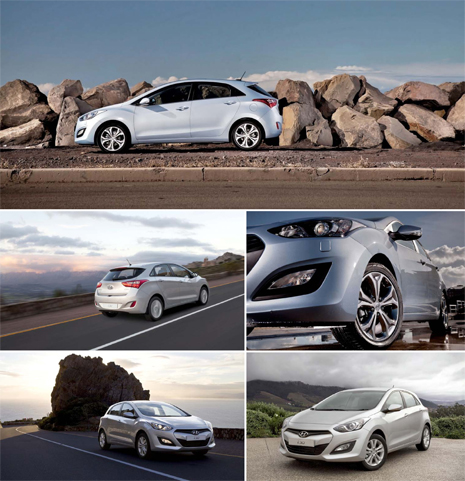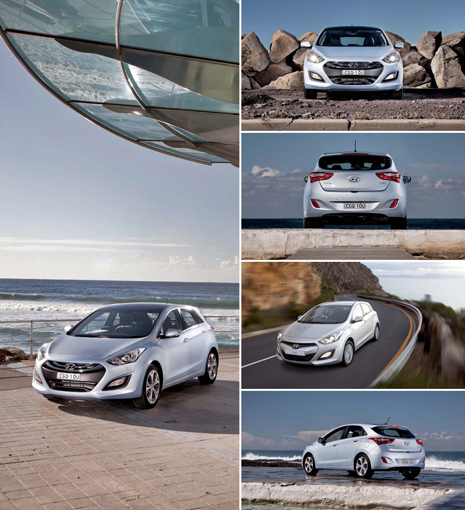Gone are the days when Korean auto brands tried (always unsuccessfully) to copy their European rivals, while using old-generation technology. Today, the likes of Hyundai and sister brand Kia not only design and develop their own, unique vehicles, but also have the European marques very, very worried.
Take the new Hyundai i30, for example. Offered in three models, with a choice of two engines and two gearboxes, the marque’s new C-segment hatch contender looks more sculpted than its rounded, blobby predecessor. It’s a hatchback that turns heads – and it needs to, because its playing field is filled with big-name rivals.
The Volkswagen Golf is something of a C-segment benchmark, while Toyota’s Auris lacks imagination, but benefits from that brand’s robust reputation. The latest Ford Focus also sets high dynamic and technology standards, while Opel’s Astra, the Renault Mégane and the Peugeot 308 offer viable, if underrated, alternatives to the mainstream players.

In this group, the i30’s European styling stands it in good stead. The hatchback was penned at Hyundai’s German design centre in Rüsselsheim, and the result is a confidently executed shape that exudes a strong identity.
Hyundai makes much of its design language, which it calls ‘fluidic’ styling. And indeed, the brand’s latest cars do boast a smoothly sculpted look, even though those carved lines and contours can look too contrived in some iterations. In the i30’s case, however, the design is expressed with aplomb.
The front end is aggressively tapered, combining clear-lensed, slanted headlights, a profiled bonnet and a slim upper grille to create a strong identity, while the steeply raked windscreen emphasises the car’s streamlined features.
The side profile is dominated by the accentuated rounding of the wheel arches, linked by a sharply creased style line that runs the length of the car. The scalloped flanks suggest a measure of athletic intent, as do the 17-inch wheels.
The rear’s most obvious feature is the concave surface of the tailgate, which tips a hat, stylistically, to BMW’s 1-Series. Indeed, if there is a criticism of Hyundai’s automotive design in general, it is the ongoing and unnecessary preoccupation with German premium brands, despite presiding over a distinctive design language of its own.
The round-edged rear screen is quite small, and capped by a subtle spoiler, complete with third brake light. By comparison, the integrated bumper is bold and almost bulbous, while also concealing the exhaust tailpipe.
Compared to exterior styling, the importance of the interior is often overlooked. But in reality, it’s a key facet of the driving experience, because it’s the cabin that facilitates the interface between car and driver. Regardless of what a car looks like, or what the specs suggest, it’s the tactile experience behind the wheel that really counts.
In that context, the i30’s cabin is a feel-good space. It delivers an upmarket message, while echoing some of the exterior styling cues.
The driver gets a leather-trimmed steering wheel with multifunction controls arranged on the spokes. It frames twin analogue dials in chrome-trimmed housings. The trip computer readout between the dials provides a digital counterpoint.
The centre stack is detailed in aluminium-look trim, and provides a home to the audio and climate control systems, while soft-touch plastics on the dashboard add to the palpable appeal of the car.
The leather-upholstered front seats are both comfortable and fully adjustable, so that dialling in just the right driving position is easy.
For a compact hatch, the list of standard kit is extensive. It includes niceties such as Bluetooth telephony and audio, as well as a USB connection (and a stereo analogue mini-jack for non-iPhone users).
Looking after passive and active safety are six airbags, all-disc ABS brakes, and stability control. Those pushing into corners too hard will find that there’s also the combination of the stability control, and speed-scrubbing understeer, to get them out of trouble.

Rear accommodation is adequate for a car in this class, while the luggage compartment’s 378-litre capacity is also competitive in this segment, even though a deep floor and raised sill make it look smaller than it is – and slightly awkward to access.
As usual, the rear seatback is split and can be folded forward to boost cargo capacity when required. In the South African context, the full-sized spare wheel is good news, and an aspect often overlooked by rival brands.
The i30 is offered with a choice of two four-cylinder engines – both designed in-house by Hyundai. At the entry level is a 1.6-litre unit, but we got to drive the flagship model, powered by the range-topping 1.8-litre power plant. A six-speed manual gearbox is the only choice – those preferring auto boxes will have to opt for the smaller-engined version.
The all-aluminium engine is brand new, and was designed in-house by Hyundai. It features both constantly variable valve timing and variable induction, and is credited with 110kW of maximum power, linked to a torque peak of 178Nm. However, both maximums are reached a fairly high engine speeds, suggesting an inherently peaky nature.
Indeed, while the engine’s output figures appear generous compared to those of its competitors, the i30’s real-world dynamics are not nearly as sprightly as its power-to-weight ratio of 91kW per tonne suggests.
On the move, the i30 feels peppy, but it’s no rocket ship – as the performance figures confirm. The 0-100km/h sprint is despatched in 9.7sec, while top speed is 190km/h – which, interestingly, is 5km/h slower than the 1,600.
The real culprit here is the gearbox, which is equipped with ratios that are too tall, especially as far as the top two gears are concerned. Sixth is an overdrive gear good for straight and level cruising only. To overtake, you’ll need to gear down once, and probably twice – and tackling even moderate uphills will be a fourth-gear endeavour, too.
I drove the car at sea level, where its full output is available. But a significant portion of 130i owners will operate the car at the Reef’s thin-air altitudes, where normally aspirated engines suffer a power loss of about 18% – which will compromise performance further.
Pitch the i30 into some twists and turns, and the car reveals a benign and user-friendly personality. The steering is over-assisted, which takes some getting used to, but once settled into a corner, it feels planted, with ample grip and composure.

Acknowledging that electric power steering tends to feel artificial and remote, Hyundai has equipped the i30 with adjustable steering assistance, allowing the driver to choose between comfort, normal and sport modes.
It’s an innovative attempt to add some substance to the anodyne steering feel, but even on the sport setting, there’s too little feedback, while the comfort setting is good for old ladies in parking lots only.
Bigger 18-inch wheels and fatter rubber would be a more effective way to endow the steering with extra heft. The chassis certainly deserves better: it’s clearly capable enough, while the suspension provides the right mix of damping and composure to encourage enthusiastic driving.
The Hyundai i30 is a convincing contender in a segment that used to be dominated by marques like Volkswagen, Ford and Toyota. It brings high-spec, refined dynamics and good value for money to the battle, and as such, it’s likely to become a popular compact hatch choice.
If anything, the i30 serves as a warning that the big guns can no longer take their dominant position for granted. Hyundai’s ever-stronger brand equity, escalating product excellence and – perhaps most importantly – compelling value offering have given the Korean marque some impressive artillery of its own. DM
VITAL STATISTICS
Hyundai i30 1.8 GLS
- Engine In-line four-cylinder, 1,797cc, DOHC
- Gearbox Six-speed manual
- Power 110kW @ 6,500 rpm
- Torque 178Nm @ 4,700 rpm
- 0-100 km/h 9.7sec
- Top speed 190km/h
- Fuel consumption 6.5 l/100 km (combined cycle)
- CO2 emissions 157g/km
- Retail price R249,900




